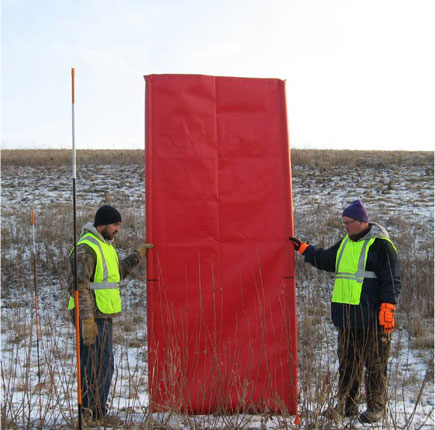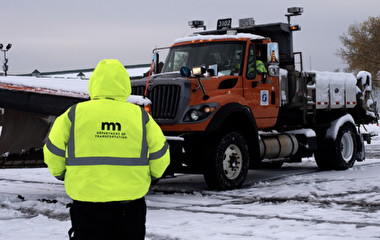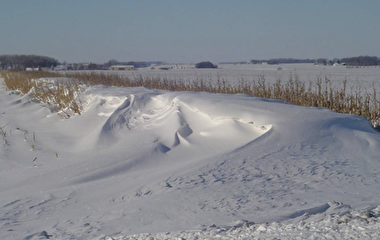shrub willow living snow fences. Photo: U of M Extension
University of Minnesota Extension researchers have identified and tested a promising plant that has the potential to make the creation of living snow fences faster and more affordable. The plant—shrub willow—also could become a source of biomass and income for farmers.
When planted alongside rural roadways, living snow fences—rows of trees, shrubs, or other vegetation—serve as windbreaks to keep snow and ice from blowing off farm fields and onto roads. They help improve safety for drivers while reducing maintenance operations costs for local agencies.
“Shrub willows have been used successfully for living snow fences in other states,” says lead researcher Diomy Zamora, Extension Professor/Extension Educator. The shrubs are easily planted with dormant stem cuttings, have fast growth rates, offer numerous ecosystem services, are adaptable to an array of growing conditions, and even have the potential to serve as a fuel for biomass energy production. “Because of their numerous benefits, we wanted to determine whether shrub willows would work for living snow fences in Minnesota,” he says.
Despite the many benefits of living snow fences, adoption has been slow. In most cases, state-owned rights-of-way are not wide enough to accommodate living snow fences; they must be planted on private land, and many farmers don’t have the time or money to invest in planting or maintaining them or are reluctant to remove cropland from production.
In the first part of the research project, researchers evaluated designs for living snow fence plantings at a test site along a Minnesota Department of Transportation (MnDOT) right-of-way. In 2013 they planted three shrub willow varieties in both two-row and four-row arrangements. During the next two growing seasons, they measured the plants’ growth and snow-trapping ability.
“The willows had high survival and growth rates after two growing seasons, with the potential to trap all of the mean annual blowing snow at the site after three or four growing seasons,” says Zamora. “We also found that the four-row plantings tended to catch more snow than the two-row plantings, and that many different shrub willow varieties make effective living snow fences.”
Researchers also worked to determine the costs of planting shrub willow living snow fences and the viability of harvesting the shrub willows for biomass energy. They discovered that shrub willows are easier to plant and more cost-effective to install than other plants used for living snow fences in Minnesota; they estimated the cost of a 100-meter, four-row living snow fence at less than $8,000.
MnDOT is planning to implement findings from the research project. “We are currently developing plans for two shrub willow living snow fence plantings to be installed in the spring of 2016,” says Dan Gullickson, MnDOT’s living snow fence coordinator.
The team found that the cost of using shrub willows for biomass is likely prohibitively expensive for the individual farmer and that there is currently little demand for shrub willow biomass in Minnesota. “However,” Zamora says, “if an entire corridor was planted as a shrub willow living snow fence, it could compete with field-scale production and provide a possible energy source in the future.”
A webinar recording about this MnDOT-sponsored research—covering the establishment, design, functionality, and potential environmental impacts of the plant—is available online.
Overall, researchers believe shrub willows have a high potential for providing effective and affordable living snow fences in Minnesota, which bodes well for future growth in this cost-saving—and potentially life-saving—transportation program.



